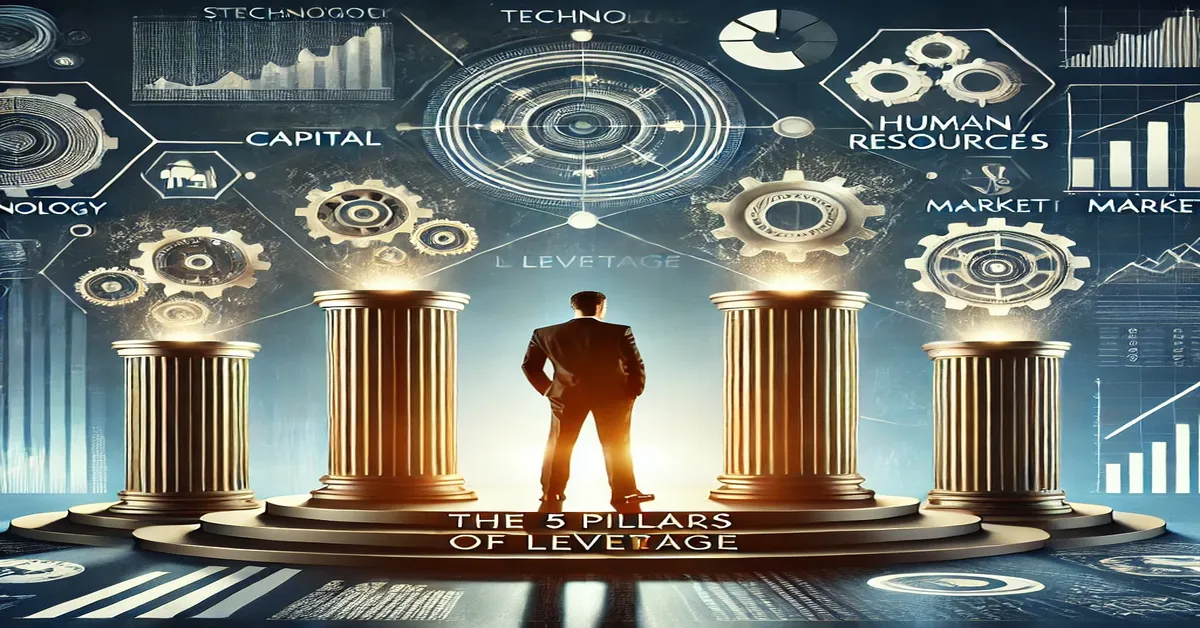Building a successful business is a journey that requires not only effort but also the strategic use of resources to maximize outcomes. This is where leverage becomes a game-changer. The concept of leverage is rooted in Archimedes’ principle: “Give me a lever long enough and a fulcrum on which to place it, and I shall move the earth.” In business, leverage is about using the resources, skills, and systems available to create exponential impact. This article explores The 5 Pillars of Leverage in Business and how they can empower growth and efficiency.
What is Leverage in Business?
In a business context, leverage means utilizing resources or assets to amplify results with minimal additional effort. Instead of relying solely on hard work, business leverage allows you to use strategic tools to optimize performance. From human talent to technology, these resources act as levers that provide a higher return on investment.
The First Pillar: Financial Leverage
Financial leverage is often the first thing that comes to mind when we think of leverage in business. It’s about using financial tools, such as loans, lines of credit, or investor funding, to increase the capital available to grow the business. With financial leverage, a business can take on larger projects, expand into new markets, or acquire assets that would otherwise be unaffordable.
How Financial Leverage Works
By borrowing or attracting investment, a business can access more capital than it has on hand, allowing it to pursue larger goals. For instance, a startup might use financial leverage to build an innovative product, knowing that the potential returns outweigh the initial costs. However, financial leverage requires careful management to avoid excessive debt and interest costs.
Benefits and Risks of Financial Leverage
When used wisely, financial leverage can yield high returns. But it’s essential to evaluate risks, such as fluctuating interest rates or repayment obligations, to ensure that the financial burden remains manageable.
The Second Pillar: Human Leverage
Human leverage refers to maximizing the talents, skills, and knowledge of your team. No business owner can do everything alone; it’s the synergy of a skilled workforce that drives long-term success. By assembling a talented team and empowering them with the right tools and training, businesses can accomplish more in less time.
Delegating Tasks for Maximum Efficiency
Effective delegation is a cornerstone of human leverage. Business owners who recognize the unique strengths of their team members and delegate tasks accordingly can focus on strategic initiatives rather than operational details. By assigning the right tasks to the right people, leaders can ensure quality while freeing up their own time for bigger-picture work.
Building a High-Impact Team
Human leverage isn’t just about delegation but also about fostering a motivated and engaged team. Businesses that invest in professional development and create a positive work culture often see higher productivity and employee loyalty, both of which amplify leverage.
The Third Pillar: Technological Leverage
Technological leverage has become one of the most powerful tools in modern business. From automation and artificial intelligence to data analytics, technology streamlines processes, improves accuracy, and enhances customer experiences. Businesses that leverage technology effectively can outpace competitors and optimize resources.
Automation as a Lever
Automation reduces manual tasks, allowing businesses to operate more efficiently and with fewer errors. Repetitive processes like data entry, customer communication, and inventory management can all be automated, saving time and reducing labor costs.
Data-Driven Decision Making
Leveraging data analytics allows businesses to make informed decisions based on insights into customer behavior, market trends, and operational efficiency. With accurate data, business leaders can better predict outcomes and make strategic adjustments quickly.
The Fourth Pillar: Marketing Leverage
Marketing leverage is the strategic use of tools and platforms to amplify a brand’s reach and engage customers on a larger scale. Effective marketing connects businesses with their target audience in ways that are memorable and meaningful. By leveraging various marketing channels, businesses can drive sales, increase brand awareness, and build customer loyalty.
Content Marketing and SEO
Content marketing, combined with search engine optimization (SEO), allows businesses to leverage online visibility. By creating valuable content and optimizing it for search engines, businesses can attract a steady stream of organic traffic, building brand authority and trust with minimal ongoing costs.
Social Media and Influencer Partnerships
Social media platforms provide powerful leverage for reaching audiences and fostering engagement. Collaborating with influencers or industry leaders can also amplify reach, tapping into established networks and engaging a larger audience with each campaign.
The Fifth Pillar: Time Leverage
Time leverage is all about optimizing time spent on tasks that contribute the most value to the business. While time is a finite resource, how it’s used determines productivity and efficiency. By focusing on high-impact tasks, business owners can maximize output without working longer hours.
Prioritizing Tasks
Understanding which tasks have the highest impact on business goals is essential for effective time leverage. Business owners should prioritize projects that drive revenue, improve customer satisfaction, or increase efficiency, delegating or automating other tasks to free up time.
Systems and Processes
Establishing systems and standardized processes can save time by minimizing repetitive decision-making and reducing errors. Clear workflows and efficient processes create a structure that allows the business to function smoothly even as it scales.
The Power of Combining the Five Pillars
Each pillar of leverage in business has its unique benefits, but when combined, they can create a highly efficient and resilient operation. For example, a company might use financial leverage to invest in technology, human leverage to build a skilled team, and marketing leverage to reach more customers. The synergy of these pillars multiplies the effect, driving greater success with fewer resources.
How to Apply Leverage in Your Business
Step 1: Identify Your Core Strengths and Weaknesses
Understanding your business’s strengths and weaknesses allows you to see where leverage is most needed. For example, if marketing reach is limited, focusing on marketing leverage might yield the best results. If processes are inefficient, technological leverage may be the solution.
Step 2: Prioritize High-Impact Leverage Areas
Evaluate which pillar of leverage will deliver the highest return for your business. This prioritization helps direct time and resources toward the areas that will make the most difference The 5 Pillars of Leverage in Business.
Step 3: Implement Gradually and Track Results
Implementing leverage strategies gradually allows you to adjust and optimize as you see results. Tracking the impact of each leveraged area ensures that the business continues to grow and adapt effectively The 5 Pillars of Leverage in Business.
Conclusion
The five pillars of leverage—financial, human, technological, marketing, and time—are essential tools that empower businesses to grow efficiently and sustainably. By understanding and implementing these pillars strategically, business owners can create a framework that not only supports growth but amplifies their potential to succeed in competitive markets The 5 Pillars of Leverage in Business.
FAQs
What is leverage in business?
Leverage in business means using resources strategically to amplify results without significant additional effort.
Why is financial leverage important?
Financial leverage allows businesses to access more capital for growth, increasing potential returns with manageable risk.
How can technology provide leverage?
Technology streamlines operations, reduces errors, and provides data insights, enhancing efficiency and productivity.
What is human leverage?
Human leverage involves maximizing the talents of team members, which increases efficiency through effective delegation and collaboration.
How can time be leveraged in business?
Time leverage involves prioritizing high-impact tasks and creating efficient processes to maximize productivity without extending work hours.
What’s an example of marketing leverage?
Marketing leverage includes using content marketing or social media to reach a larger audience, building brand awareness with minimal costs.
Can the pillars of leverage work together?
Yes, combining multiple leverage pillars can create exponential growth and efficiency, allowing businesses to thrive with fewer resources.
How do I start applying leverage in my business?
Begin by identifying your business’s needs, then prioritize and implement leverage strategies gradually, tracking results to optimize over time.







